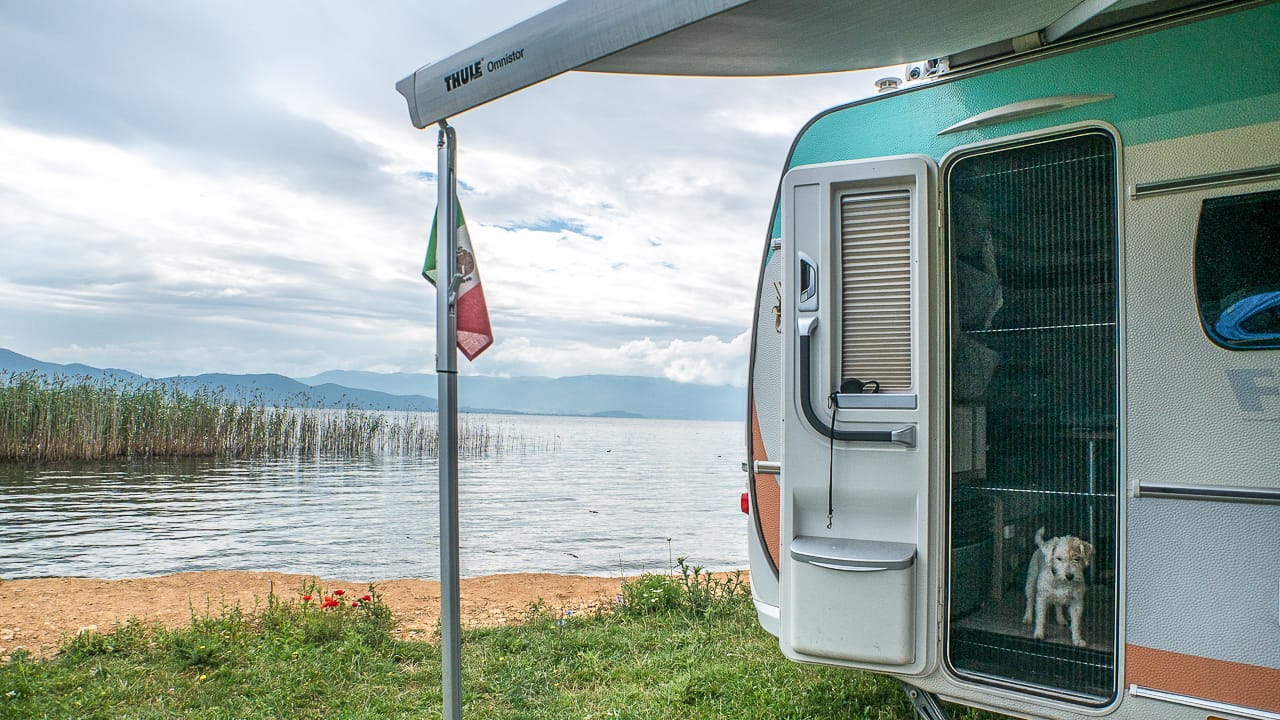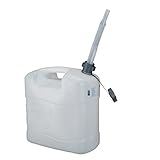Unlimited freedom – for many (experienced) campers, this also means being self-sufficient and camping independently of pitches, supply stations and power sockets – only where permitted, of course. And not just for one day, but over a longer period of time.
At this point, many campers realize that the boundless freedom here can come to an end sooner than they would like. Can, not must – because with the right products you can convert your caravan to be self-sufficient. I’ll show you what you should bear in mind and what ways there are to experience boundless freedom. An overview of how you can convert your caravan to be self-sufficient.
Inhaltsverzeichnis
- The analysis: What have you got? What do you need?
- Gas supply: Always make sure the cylinders are full
- Power supply: Numerous options for independent travel
- Water: fresh water tank, canisters and water cabs
- Toilet: Classic cassettes and alternatives
- Converting a caravan to be self-sufficient – what options are there?
- Conclusion
The analysis: What have you got? What do you need?
Unlike motorhomes, caravans are not designed to be self-sufficient by nature – this starts with the towing vehicle required to move around and ends with the water supply in the living area. But with a few useful conversions and a little technical skill, caravans can become equally perfect companions for self-sufficient travel – within the limits of the physical conditions, of course.
This also includes: Always pay attention to the payload weight for all conversions!
To begin with, it is advisable to analyze the caravan in detail: What do you have? What do you need? What do you need to change as a result of the difference between the two answers – for each of the following points?
- Gas
- Electricity
- Water
- Waste water
- Toilet.
When looking at the status quo, most of you will realize: Caravans usually do not have an on-board battery, a relatively small water tank and an equally small (often mobile) waste water tank, space for two 11 kg gas bottles and a chemical toilet.
To make a caravan self-sufficient, you need a few conversions and additional equipment – below you will find numerous options for making your caravan fit for self-sufficient travel.

Gas supply: Always make sure the cylinders are full
Let’s start with gas: this is pretty straightforward. The space for the gas cylinders is located in the drawbar box in the caravan. There is usually space for two 11 kg bottles.
The gas can be used for heating, for the refrigerator (in the case of an absorption refrigerator) and – if there is no electricity on board – to operate essential appliances inside the caravan. If you want to be self-sufficient on the road, always make sure your gas bottles are full. That was the simplest point.
If you are staying abroad for a longer period of time and may need a local gas cylinder you will need an appropriate adapter for your adapter to connect the foreign cylinder to your German system.
The following set is perfect for this:
- Immer gut vorbereitet – Das praktische PELMOS Gasflaschen Anschlussset bietet Ihnen die…
- Rostfrei & Langlebig – Unsere Gasflaschenadapter werden in einem speziellen Verfahren aus…
Power supply: Numerous options for independent travel
The power supply in the caravan is a little more complex if you want to be self-sufficient. At the campsite, you plug the caravan into the shore power – and everything works. When analyzing “How much electricity do you need?”, it is helpful to create a short Excel spreadsheet with all consumers:
What do you run on electricity? How many hours per day? This is used to calculate the minimum number of ampere hours and therefore watt hours you need per day.
If you also value a 230 V supply when free-standing, you need to consider whether it is worth installing an inverter.
This is because some appliances such as hair dryers or coffee machines only work with 230 V – and therefore only with a connection to the shore power or with a built-in inverter that converts the 12 V voltage of the on-board battery into 230 V.
At the same time as the analysis, you should also consider how you can reduce your electricity consumption. Uncomplicated approaches here include switching the lighting to LED or checking whether the fridge can run on gas. These two factors already save an enormous amount of electricity if you are not connected to shore power.
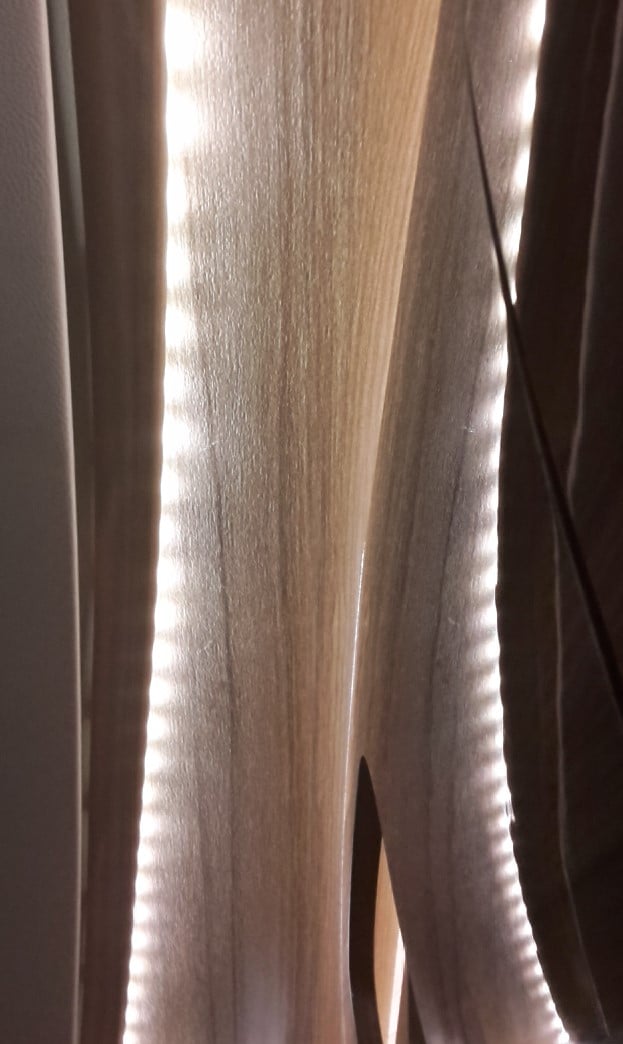
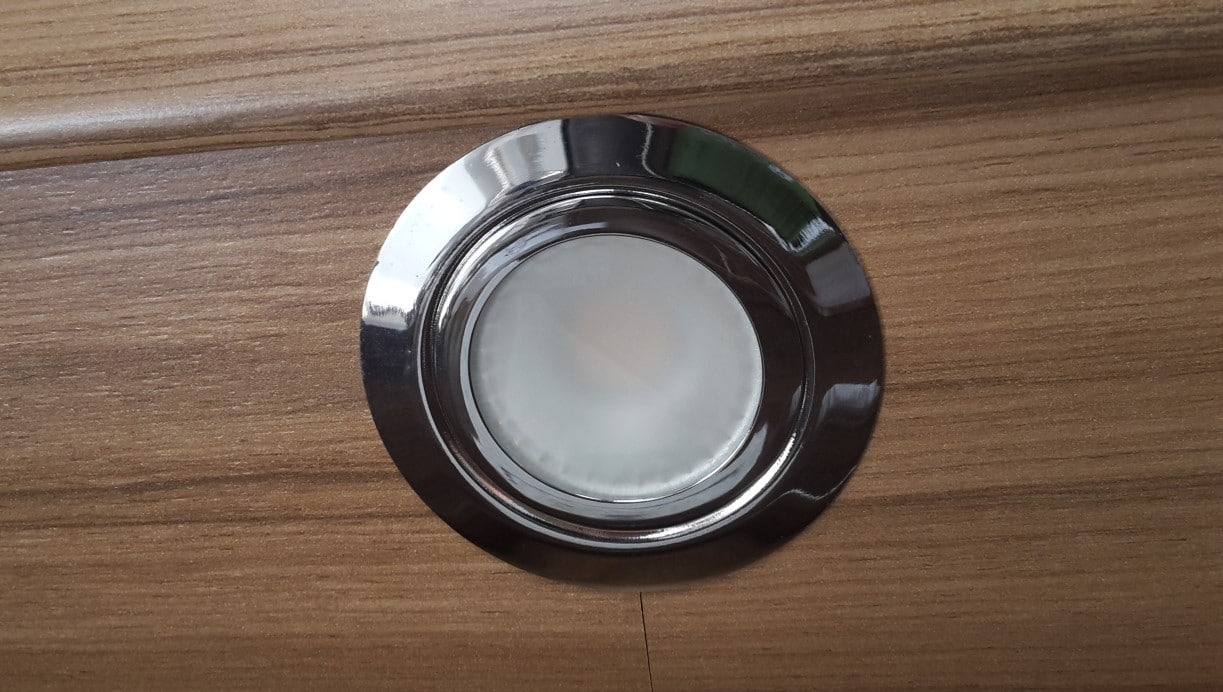
Photos: © Katja Scholz
This is because most caravans do not have an on-board battery installed ex works, which you can use to supply numerous 12 V consumers. The first step on the road to freedom is therefore the installation of a suitable on-board battery.
The cheapest batteries to buy are gel or AGM batteries, and the most efficient and long-lasting are the so-called “LiFePo4”, i.e. lithium-ion batteries. Although these cut into the budget at first, we believe they offer by far the best value for money in the long term.
You can find out more in our podcast:
There is usually space for the battery under a seat bench or in the storage box. If you are considering getting a mover (maneuvering aid) for your caravan anyway, you can think about whether you should opt for a more powerful battery so that you have your own 12 V supply on board. You have the following options for charging them regularly without shore power during longer periods of self-sufficiency:
Solar modules, solar case or solar bag
Whether permanently installed solar modules on the roof of your caravan or a mobile version – solar case or solar bag – in your luggage: there are numerous solar sets on the market in a wide variety of versions.
In our podcast, we conducted an in-depth interview with experts on this topic. Here you can find out exactly what is important when selecting and calculating the right solar system:
You can also take a look at our article on mobile solar systems to see which one is perfect for you.
Fuel cell
This is a second, very practical solution for caravan owners. The absolute advantage over a solar solution is that it works completely independently of the weather.
Powered by methanol fuel cartridges, the fuel cell generates electricity whenever the voltage of the on-board battery falls below a certain level. With this solution, you should bear in mind that the cartridges cost around 40 euros for ten liters of methanol.
Depending on the fuel cell type, size and output, a cartridge lasts up to six months with average consumption. It is more cost-effective if you combine the fuel cell and the solar solution – then you are well supplied whatever the weather.
Find out more in our article on the Efoy fuel cell in caravans.
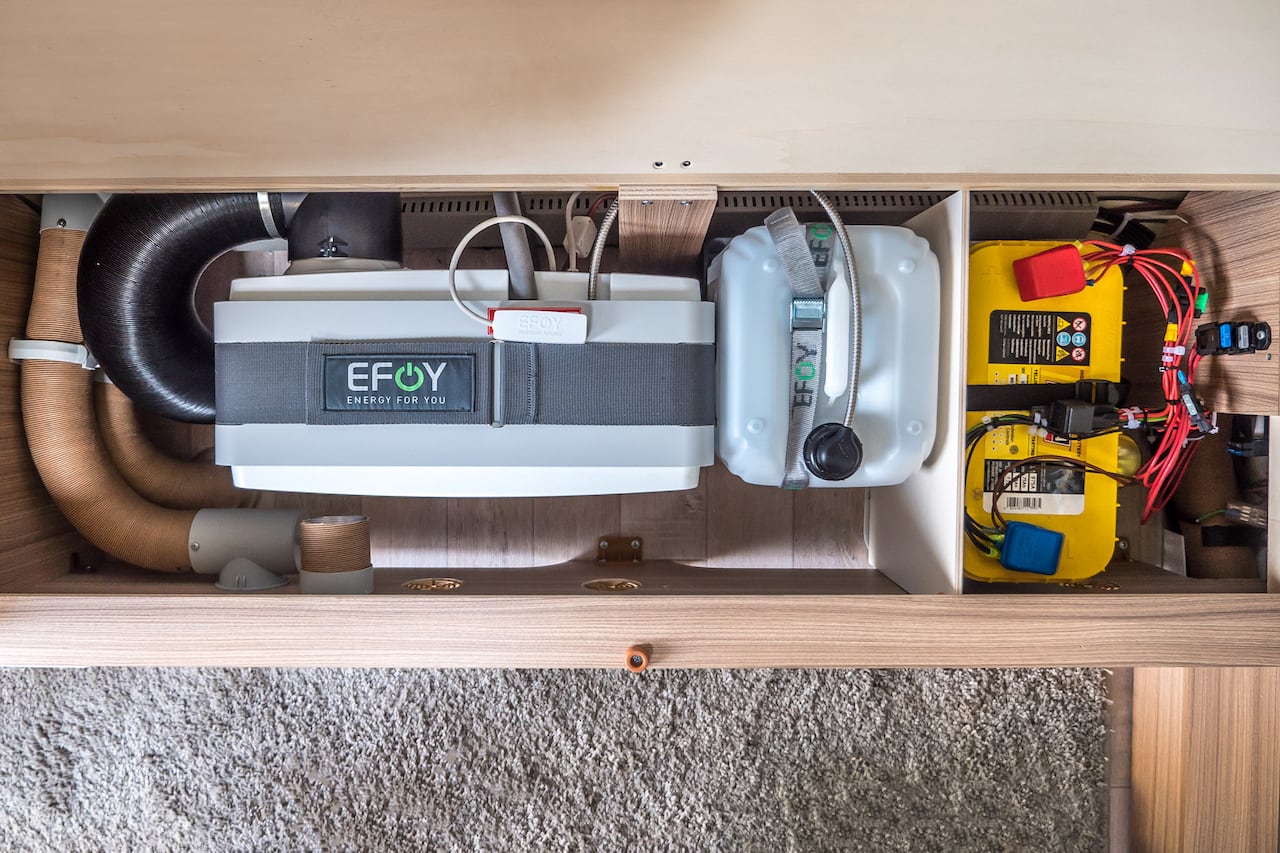
Photo: © CamperStyle
Powerstation with 12 V or 230 V
Handy, flexible and can be used without additional installation – electricity from a power bank is a very convenient, but not always cost-effective option.
You have a portable battery with various connections for USB, 12V and 230 Volt devices. You can charge them with 12V, 230V and solar. Here is an example of a power station with solar that we use ourselves. On the left the small version for small caravans and cars, on the right the larger version for panel vans and large caravans:
Of course, we have also written a detailed article on power stations.
A quick energy boost: charging boosters
To charge the on-board battery efficiently while driving, even over short distances, a so-called charging booster is recommended. This charges the battery via the towing vehicle’s alternator.
So, to summarize: To be self-sufficient, you need an on-board battery to be independent of power sockets, a charger to charge the battery regularly (using the options mentioned: Shore power, solar, fuel cell, charging booster) – and an overview of your electricity consumption so that you can put together the right electricity self-sufficiency package for you.
Water: fresh water tank, canisters and water cabs
Having enough fresh water on board is essential for self-sufficient standing – especially if you don’t know of a reliable water supply at your destination. However, it is just as important to dispose of the fresh water used, i.e. the waste water or gray water, correctly. It is possible to calculate your personal fresh water consumption for several days – but to be on the safe side: the more, the better. But always with an eye on the payload weight.
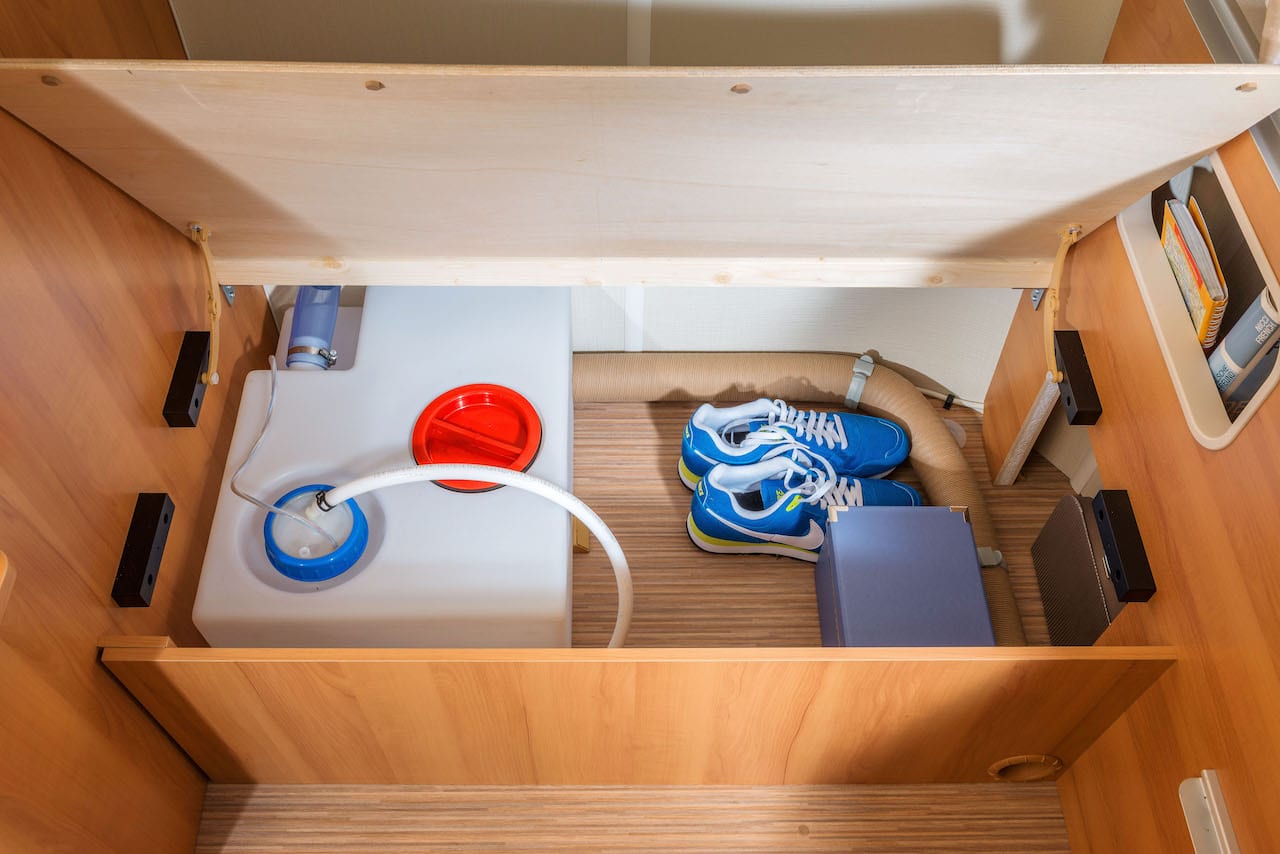
Photo: © Hymer GmbH & Co. KG / ERIBA
The fresh water tank in the caravan is small by design with a maximum of 45 l and is not designed for long, self-sufficient journeys. Depending on the space available, you can opt for a larger fresh water tank – there are numerous sizes on the market between 50 l and 100 l. You should calculate your water requirements here – but the more decisive factor will probably be the structural conditions in the caravan, which set limits on the size. A practical solution is therefore to carry extra fresh water in additional water canisters.
- Sehr robuster Kanister mit Ausgießer
- Robuster Kanister mit starkem Henkel
Or in a larger version:
- Robuste Bauweise: Der plasteo 30 Liter Getränke-Wasserkanister ist aus hochdichtem Polyethylen…
- Pracktisch und Lebensmittelecht: Der Kanister ist für die sichere Aufbewahrung von Lebensmitteln,…
The topic of waste water in caravans is more interesting: so-called water cabs are usually part of the basic equipment – mobile tanks that are placed under the gray water pipe:
- Praktischer Grauwassertank mit neuem und bequemen Abflußverschluss.
- Praktischer Grauwassertank mit neuem und bequemen Abflußverschluss.
You have several options here: Empty the tank regularly or carry a second spare tank for emergencies in case there is no disposal facility nearby.
You can find nearby waste disposal stations in various camping and pitch apps, some countries offer their own lists on the internet – often divided into areas and municipalities – or you can keep an eye out for signposted dump stations. This is less advisable in Germany, but in the Scandinavian countries you will often find what you are looking for quickly this way.
As a further step towards self-sufficiency, you can check whether you have space under your caravan for a permanently installed waste water tank, which is then drained via a valve – as in motorhomes. However, this is not possible for all models in a reasonable size. Mobile solutions are therefore still the number one way to make the caravan self-sufficient in terms of water supply.
Another – albeit very cost-intensive – option is to install a water treatment system. This means you are largely independent of the external water supply.
Toilet: Classic cassettes and alternatives
As a camper, you not only have to dispose of the waste water, but also the chemical toilet. A standard toilet cassette with a capacity of around 15 to 20 liters is usually installed in caravans ex works. For longer, self-sufficient periods without disposal facilities, this is normally only enough for a few days – experience has shown that for two adults this is around three days.
Here too, as with waste water, some campers resort to carrying a second toilet cassette. With all this in mind, however, you need to bear in mind the payload and the space required. As an alternative to a second cassette, there are also ways to save money here: Using less flushing water can save a few liters per day, other campers put the toilet paper in a separate container.
This is because the paper is a volume that should not be underestimated and quickly fills up the tank.
- WC MOBIL + FLUSH SPRAY IM BUNDLE: Mit dem 2er Set aus wc mobil und flush spray sind Sie für die…
- WC MOBIL ERLEICHTERT ENTLEERUNG DES TANKS: Die Sanitärflüssigkeit zersetzt Fäkalien und…
If necessary, you can also consider installing an alternative to the classic chemical toilet. With separating toilets the solids and liquids are collected separately in the toilet bowl using an appropriate insert. Both can be disposed of separately: the solid in the residual waste, the liquid in a normal toilet. Depending on the toilet variant, the waste is also composted directly.
Also incinerating toilets are also an option. This variant is very expensive, costing around 4,000 euros to purchase and install, and requires a lot of gas for combustion, but the worries of emptying are a thing of the past.
Converting a caravan to be self-sufficient – what options are there?
Now it also depends on your manual skills and technical understanding whether you work in “do it yourself” mode or prefer to leave the necessary conversions in the hands of professionals.
“Self-sufficient packages”
One option when buying a new caravan is to order additional basic equipment straight from the factory, such as a larger fresh water tank. Most manufacturers also offer a “self-sufficient package” for new caravans. These vary depending on the manufacturer and type of caravan, but essentially contain the components relating to the battery and power supply.
The manufacturer Hobby, for example, offers a charge controller with booster, a body battery, a battery sensor and box, a 47-liter fresh water tank, a city water connection and a TFT control panel for convenient operation in its “Autark-Paket+”. The manufacturer Fendt, for example, offers two self-sufficient packages with a 55 Ah or 75 Ah battery as well as a charger, an isolating switch and isolating relay, special circuits and a battery charge level indicator. The “Autark Plus” package also includes a charging booster.
The advantage of such self-sufficient packages: They match the caravan type. They utilize existing cavities for the battery or water tank and are therefore very space-saving. The disadvantage is often the cost compared to the “do it yourself” variant.
Make yourself self-sufficient
If you do it yourself, you can assemble the individual components and then install them yourself. For a solar power system, you generally need solar modules for the roof with suitable brackets, a solar charge controller and corresponding connection cables.
A second option is to buy a ready-made kit, which you can also use to convert the caravan yourself. If you don’t consider yourself to be very handy, you can also have the conversion carried out by a specialist dealer or workshop.
But beware: they usually order the individual components themselves and do not work with the individual parts you ordered – the reason for this is the warranty claims. When choosing a self-sufficient set, you should make sure that it also fits your caravan model.
And what does it all cost?
“How expensive is it to convert a caravan to be self-sufficient?” As important as the question is, it is difficult to answer. Of course, it depends on what you want to retrofit, which of the possible products you decide on and whether you carry out the conversions yourself.
However, to give you an idea of what you might have to expect, here is a sample calculation for the purchase of individual components. Please note: pure material costs, without installation.
[su_table responsive=”yes”]
| Gasversorgung | |
| 2x 11-kg-Gasflaschen | ca. 70 Euro komplett, nur Füllung ca. 40 Euro |
| Stromversorgung | |
| Gelbatterie 120 Ah / 220 Ah | ca. 120 Euro / 240 Euro |
| AGM-Batterie 100 Ah | ca. 200 Euro |
| Lithium-Ionen-Batterie (LiFePo4) 100 Ah | ab ca. 900 Euro |
| Wechselrichter | ab ca. 500 Euro |
| Solarpanels für das Dach 180 W inkl. Zubehör | ca. ab 600 Euro |
| Solartasche 180 W inkl. Zubehör | ca. ab 600 Euro |
| Brennstoffzelle | ca. 2.500 Euro bis 5.500 Euro |
| Energiekoffer | ab ca. 800 Euro |
| Ladebooster | ab 100 Euro |
| Wasserversorgung | |
| Wassertaxi 25 l | ca. 60 Euro |
| Wasserkanister 10 l | ca. 10 Euro bis 20 Euro |
[/su_table]
The costs of the manufacturers’ self-sufficient packages vary enormously depending on the contents, caravan type and manufacturer, making it difficult to provide reliable information. The safest thing to do here is to ask the manufacturer in question and make your own comparison.
Conclusion
You’ve discovered that you’re the self-sufficient caravan type who likes to travel independently and have been able to pick up a few tips for your project here! Then good luck on the way to your self-sufficient caravan. How independent you are ultimately depends on the individual conversions as described. But one thing is certain: whether it’s a solar system, CamperCase or a permanently installed waste water tank – every conversion step brings you one step closer to limitless freedom.
[su_box title=”Das wird dich auch interessieren:”]
- Podcast: Autark mit Wohnmobil und Wohnwagen
- Solaranlage auf dem Wohnmobil – eine Montageanleitung
- Kostenloses E-Book: Basiswissen Wohnwagen
- Checkliste: Erstausstattung für Wohnwagen & Reisemobile
- Führerschein für Wohnwagen und Gespanne
- Wohnwagen-Zusatzspiegel: Anbieter, Modelle, Tipps
- Anhängelast bei Steigungen – Prozentrechnung leicht gemacht?
- Wohnwagen im öffentlichen Raum parken: Wie sind die Regeln?
- TÜV für Wohnwagen: Das solltest du zur Hauptuntersuchung wissen
- Es geht wieder los: Wohnmobil und Wohnwagen für die Saison vorbereiten
- Wohnwagen abstützen und ausrichten – wie du häufige Fehler vermeidest
- Abreißseil für den Caravan richtig befestigen – Wo braucht man eine „Holland-Öse“?
- Umlaufmaß richtig ermitteln – wichtig für den Vorzeltkauf!
[/su_box]
Cover picture: © CamperStyle
Letzte Aktualisierung der Preise am 2025-12-14 / Affiliate Links / Bilder von der Amazon Product Advertising API
